The Low Point, DIfferent Skill Levels and its Mastery
THE LOW POINT, DIFFERENT SKILL LEVELS AND ITS MASTERY Low Point - Definition
Trackman measures a number called Low Point and learning to master the Low Point is an essential skill for golfers who want to make good contact with the ball and maximise their distance. The technical definition is that the Low Point represents the distance from the club head’s geometric centre to the lowest point on the swing arc at the time of maximum compression. Impact can occur either before the Low Point or after the Low Point has been reached by the club head. There is a strong correlation between Angle of Attack and Low Point as when the golfer hits down on the golf ball the Low Point is situated after the golf ball and when the golfer hits up on the golf ball the Low Point is situated before the golf ball. The illustrations below help to provide a clear understanding of the concept.
Low Point Illustration
The following picture depicts the arc the club head travels from approximately knee height on the downswing to knee height on the through swing with the bottom of the arc depicted here by a vertical white line. The lowest point on this arc is what is termed the Low Point. The ball is struck either before the club head reaches the low point with a descending angle of attack or after the club head reaches the low point with an upwards angle of attack.
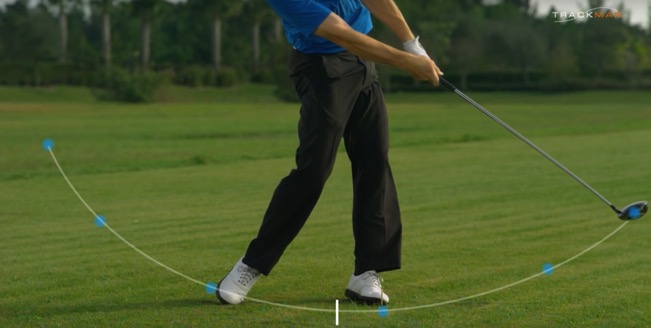
In the picture below, you can see an example of the Low Point situated just after the golf ball as the club head travels downwards through impact. The vertical dotted line indicates the position of the Low Point and the orange arrow indicates the distance before the Low Point.
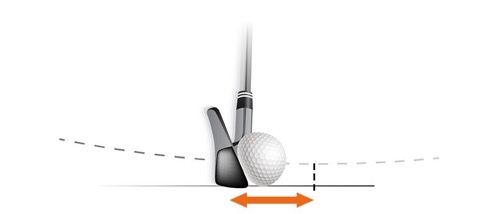
What is the correct Low Point
When the balls rests on the turf, it is necessary for golfers to hit down on the ball. This is because there is a need to strike the golf ball first and then the ground. In order to understand this think about the position of the divot after a well struck shot. It is always located on the target side of the golf ball. This signifies that the golfer’s club head is moving downwards through impact, it is a negative attack angle and a Low Point after the golf ball.
With a driver in hand, it is possible for the Low Point to be situated before the golf ball. The average angle of attack with a driver on the PGA Tour, as measured by Trackman, is -1.3 ̊ which implies the Low Point is after the ball. However, the average angle of attack on the LPGA Tour is +3 ̊, this means the Low Point is situated before the ball and the club head is travelling upwards through impact. Whatever the reasons behind this difference, be it technique, physical make-up or intention, this upward hit and Low Point position before the ball leads to a gain in potential distance. As an example, a golfer who swings at 90mph with a -5 ̊ angle of attack and makes a change that allows them to hit with a +5 ̊ angle of attack, could gain almost 30 yards in total distance. Golfers who reach the bottom of their swing arc before the ball and have their Low Point before the ball will need to consider the effect this has on the swing path as, all other things equal, this will tend to shift the club path to the left for a right hander. These golfers may therefore want to consider rotating their swing direction further to the right, or to the left for left handers, in order to compensate for this.
If we compare the average attack angle with a 7 iron on the PGA Tour with the same on the LPGA Tour, we notice that though both groups have the Low Point situated after the golf ball the women golfers don’t have the Low Point quite as far after the ball as the men. In fact, they hit down -2.3 ̊ with a 7 iron compared to -4.3 ̊ for the male golfers. The point to remember here is that though the Low Point must occur after the golf ball, there is in fact a reasonably wide range demonstrated by the world’s best players. Golfers with slower swing speeds may benefit by not having the Low Point situated too far after the golf ball as long as it remains after the golf ball.
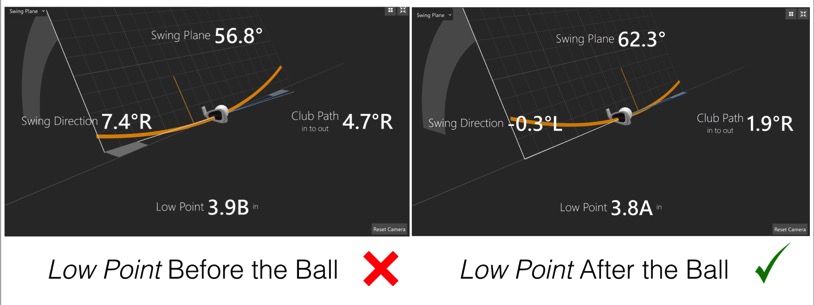
Low Point Patterns in Golfers of Different Abilities
It is important to note that the following are general patterns that I see day in and day out on the lesson tee. Of course, no two golfers are the same and each have their own individual swing tendencies. On a case by case basis, you can find golfers of different abilities who demonstrate every possible variable.
Pattern with a short to mid-iron from the fairway
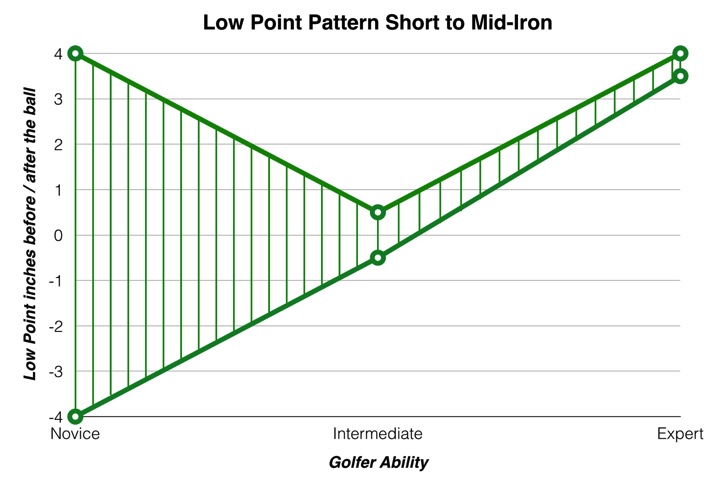
Novice Golfers Type 1 The Low Point is usually situated before the golf ball and there is a wide spread between shots. This means the club head reaches the bottom of its arc before impact and thus the club head is travelling upwards as the ball is struck. The consequence of this is that these golfers will tend to hit a number of fat and thin shots. They will generally hit thin shots when the arms flex too fast through impact, fat shots when the arms don’t flex fast enough and good shots when the arms flex just the right amount. This is a particularly chaotic procedure and makes it difficult to find any consistency in ball striking. These golfers will exhibit a flip through impact with a bending of the lead wrist as the club head overtakes the hands. These golfers are more comfortable when their ball rests sitting up on fluffy fairways or when the ball is teed up. The Dynamic loft will also tend to be too high for these golfers as they “add” loft to their club resulting in shots which reach their peak height too soon and lose distance as a consequence. Type 2 The Low Point is usually situated after the golf ball and there is a wide spread between shots. This is usually due to the fact these golfers have a severe over the top move during their downswings, the predominant trajectories are pulls and slices. These golfers will hit a number of fat and thin shots and exhibit the same tendencies through impact with the arms flexing and the club head overtaking the hands. As the club gets longer, the Low Point tends to move forwards rather than backwards as it should. These golfers normally hit their short clubs with too much loft and their longer clubs with not enough loft.
The following is an example of a Type 2 golfer changing his motion so that it is no longer over the top and shows the effect this move had on the Low Point of his swing:
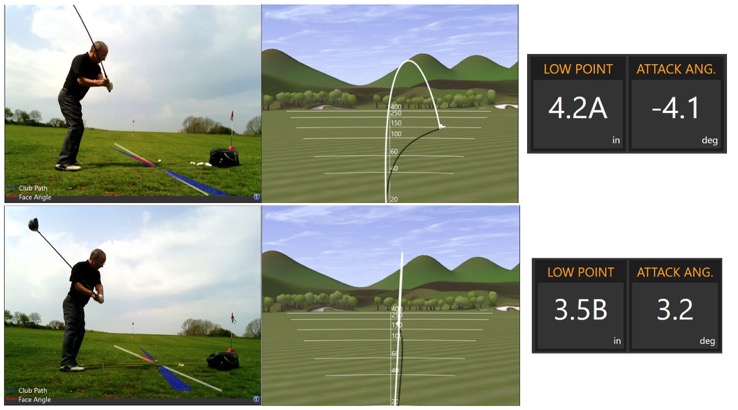
Intermediate Golfers
For these golfers the Low Point is often situated at the golf ball. This means the club head reaches the bottom of its arc during impact and thus the club head is travelling neither downwards or upwards. The Low Point varies from shot to shot but not as much as for novice golfers. These golfers will exhibit all the traits of the novice golfers but to a lesser degree. There will be some fat and thin shots and some loss of potential distance due to the loft delivered at impact even though the strikes are more solid and consistent.
Expert Golfers
In this instance the Low Point is situated after the golf ball and varies very little from shot to shot. This means the club head reaches the bottom of its arc after contact with the golf ball, as the club head is travelling downwards through impact. These players take their divots on the target side of their golf ball and their ball striking is solid with very few or no fat and thin shots. These golfers are comfortable hitting shots off tight fairways and even relish the opportunity of doing so. They exhibit a forward leaning shaft at impact with the club head trailing the hands. These players “reduce” the loft on their club, while not hitting down excessively, such that the golf ball is better compressed for golf shots that travel further.
Low Point Exercises
Knowledge of the Task at Hand
Make sure you have an understanding of the task. In order to become an accomplished ball striker when the ball rests on the ground, you must learn to hit the ball before the ground. This necessitates a descending angle of attack and a Low Point on the target side of the golf ball. On your next few shots, try and picture the Low Point of your swing on the target side of the golf ball rather than at the golf ball, this will help you create the forward leaning shaft and weight forwards configuration that is necessary to strike the ball well.
Punch Shots Hold the Finish Drill
First, mark a line on the ground using spray paint or make an indent in the ground by stepping on a dowel. Second, make some half swing practice swings where your club head makes a shallow dollar sized divot on the ground, starting on the line but not before it. To give yourself the best chance of accomplishing this, check that you finish with your arms straight, your hips forwards and your handle forwards. Second, introduce a golf ball and hit some punch shots following the same procedure. The ball should fly low and with a draw bias. Pay specific attention to your finish as it is a stationary position, thus making it possible to compare the motion you do from one shot to the next. For example you can check exactly how straight your arms are after each shot and make adjustments if needed. A good finish indicates many of the things that happened during the swing but were too fast to see were done well.
Notice in the sequence of pictures below, how clearly you can see the line on the ground as marked by the dowel. You can also observe how the hips and the shaft are forwards through impact which makes it possible to take the divot on the target side of the golf ball thus making the Low Point after the ball.

The Driver
As we have seen, having the Low Point situated slightly before the golf ball can be beneficial for hitting the ball longer distances with the driver. However, in my experience, the average golfer doesn’t have a strong enough “picture” in mind of what they are trying to achieve at impact. Quite often the Low Point is not situated sufficiently forwards because the golfer thinks he needs to assist the ball up into the air rather than let the club do the work. This is when golfers start to hang back, rather than transferring their weight forwards, and flip the wrists through impact while their arms flex, thus leading to all kinds of problems. More often than not, these moves have the opposite effect than that which is desired on the location of the Low Point. I often ask golfers what they think impact should look like and I am frequently told that it should mirror setup as closely as possible, this is not the case unless you have pre-set yourself into impact alignments before you start the swing. If you are going to work on having the Low Point slightly before the ball with a driver and an upwards angle of attack, make sure you don’t do it at the detriment of your basic impact alignments. Please ensure you achieve mastery of your Low Point by transferring your weight forwards via the motion of the hips going forwards, the body extending with the belt level rising and making an effort to keep the arms straight while the head remains centred and your inclination to the ground remaining constant. Remember also there are many things you can do to increase driver distance and altering your low point may or may not be the best option for you.
A Caveat
If the Low Point number given by Trackman indicates all is well but you are still struggling with fat and thin shots, be aware the distance between the lead shoulder and the golf ball must match the distance between the lead shoulder and the club head during impact. When this is not the case the golf ball still cannot be struck well.
Trackman measures a number called Low Point and learning to master the Low Point is an essential skill for golfers who want to make good contact with the ball and maximise their distance. The technical definition is that the Low Point represents the distance from the club head’s geometric centre to the lowest point on the swing arc at the time of maximum compression. Impact can occur either before the Low Point or after the Low Point has been reached by the club head. There is a strong correlation between Angle of Attack and Low Point as when the golfer hits down on the golf ball the Low Point is situated after the golf ball and when the golfer hits up on the golf ball the Low Point is situated before the golf ball. The illustrations below help to provide a clear understanding of the concept.
Low Point Illustration
The following picture depicts the arc the club head travels from approximately knee height on the downswing to knee height on the through swing with the bottom of the arc depicted here by a vertical white line. The lowest point on this arc is what is termed the Low Point. The ball is struck either before the club head reaches the low point with a descending angle of attack or after the club head reaches the low point with an upwards angle of attack.

In the picture below, you can see an example of the Low Point situated just after the golf ball as the club head travels downwards through impact. The vertical dotted line indicates the position of the Low Point and the orange arrow indicates the distance before the Low Point.
What is the correct Low Point
When the balls rests on the turf, it is necessary for golfers to hit down on the ball. This is because there is a need to strike the golf ball first and then the ground. In order to understand this think about the position of the divot after a well struck shot. It is always located on the target side of the golf ball. This signifies that the golfer’s club head is moving downwards through impact, it is a negative attack angle and a Low Point after the golf ball.
With a driver in hand, it is possible for the Low Point to be situated before the golf ball. The average angle of attack with a driver on the PGA Tour, as measured by Trackman, is -1.3 ̊ which implies the Low Point is after the ball. However, the average angle of attack on the LPGA Tour is +3 ̊, this means the Low Point is situated before the ball and the club head is travelling upwards through impact. Whatever the reasons behind this difference, be it technique, physical make-up or intention, this upward hit and Low Point position before the ball leads to a gain in potential distance. As an example, a golfer who swings at 90mph with a -5 ̊ angle of attack and makes a change that allows them to hit with a +5 ̊ angle of attack, could gain almost 30 yards in total distance. Golfers who reach the bottom of their swing arc before the ball and have their Low Point before the ball will need to consider the effect this has on the swing path as, all other things equal, this will tend to shift the club path to the left for a right hander. These golfers may therefore want to consider rotating their swing direction further to the right, or to the left for left handers, in order to compensate for this.
If we compare the average attack angle with a 7 iron on the PGA Tour with the same on the LPGA Tour, we notice that though both groups have the Low Point situated after the golf ball the women golfers don’t have the Low Point quite as far after the ball as the men. In fact, they hit down -2.3 ̊ with a 7 iron compared to -4.3 ̊ for the male golfers. The point to remember here is that though the Low Point must occur after the golf ball, there is in fact a reasonably wide range demonstrated by the world’s best players. Golfers with slower swing speeds may benefit by not having the Low Point situated too far after the golf ball as long as it remains after the golf ball.

Low Point Patterns in Golfers of Different Abilities
It is important to note that the following are general patterns that I see day in and day out on the lesson tee. Of course, no two golfers are the same and each have their own individual swing tendencies. On a case by case basis, you can find golfers of different abilities who demonstrate every possible variable.
Pattern with a short to mid-iron from the fairway

Novice Golfers Type 1 The Low Point is usually situated before the golf ball and there is a wide spread between shots. This means the club head reaches the bottom of its arc before impact and thus the club head is travelling upwards as the ball is struck. The consequence of this is that these golfers will tend to hit a number of fat and thin shots. They will generally hit thin shots when the arms flex too fast through impact, fat shots when the arms don’t flex fast enough and good shots when the arms flex just the right amount. This is a particularly chaotic procedure and makes it difficult to find any consistency in ball striking. These golfers will exhibit a flip through impact with a bending of the lead wrist as the club head overtakes the hands. These golfers are more comfortable when their ball rests sitting up on fluffy fairways or when the ball is teed up. The Dynamic loft will also tend to be too high for these golfers as they “add” loft to their club resulting in shots which reach their peak height too soon and lose distance as a consequence. Type 2 The Low Point is usually situated after the golf ball and there is a wide spread between shots. This is usually due to the fact these golfers have a severe over the top move during their downswings, the predominant trajectories are pulls and slices. These golfers will hit a number of fat and thin shots and exhibit the same tendencies through impact with the arms flexing and the club head overtaking the hands. As the club gets longer, the Low Point tends to move forwards rather than backwards as it should. These golfers normally hit their short clubs with too much loft and their longer clubs with not enough loft.
The following is an example of a Type 2 golfer changing his motion so that it is no longer over the top and shows the effect this move had on the Low Point of his swing:

Intermediate Golfers
For these golfers the Low Point is often situated at the golf ball. This means the club head reaches the bottom of its arc during impact and thus the club head is travelling neither downwards or upwards. The Low Point varies from shot to shot but not as much as for novice golfers. These golfers will exhibit all the traits of the novice golfers but to a lesser degree. There will be some fat and thin shots and some loss of potential distance due to the loft delivered at impact even though the strikes are more solid and consistent.
Expert Golfers
In this instance the Low Point is situated after the golf ball and varies very little from shot to shot. This means the club head reaches the bottom of its arc after contact with the golf ball, as the club head is travelling downwards through impact. These players take their divots on the target side of their golf ball and their ball striking is solid with very few or no fat and thin shots. These golfers are comfortable hitting shots off tight fairways and even relish the opportunity of doing so. They exhibit a forward leaning shaft at impact with the club head trailing the hands. These players “reduce” the loft on their club, while not hitting down excessively, such that the golf ball is better compressed for golf shots that travel further.
Low Point Exercises
Knowledge of the Task at Hand
Make sure you have an understanding of the task. In order to become an accomplished ball striker when the ball rests on the ground, you must learn to hit the ball before the ground. This necessitates a descending angle of attack and a Low Point on the target side of the golf ball. On your next few shots, try and picture the Low Point of your swing on the target side of the golf ball rather than at the golf ball, this will help you create the forward leaning shaft and weight forwards configuration that is necessary to strike the ball well.
Punch Shots Hold the Finish Drill
First, mark a line on the ground using spray paint or make an indent in the ground by stepping on a dowel. Second, make some half swing practice swings where your club head makes a shallow dollar sized divot on the ground, starting on the line but not before it. To give yourself the best chance of accomplishing this, check that you finish with your arms straight, your hips forwards and your handle forwards. Second, introduce a golf ball and hit some punch shots following the same procedure. The ball should fly low and with a draw bias. Pay specific attention to your finish as it is a stationary position, thus making it possible to compare the motion you do from one shot to the next. For example you can check exactly how straight your arms are after each shot and make adjustments if needed. A good finish indicates many of the things that happened during the swing but were too fast to see were done well.
Notice in the sequence of pictures below, how clearly you can see the line on the ground as marked by the dowel. You can also observe how the hips and the shaft are forwards through impact which makes it possible to take the divot on the target side of the golf ball thus making the Low Point after the ball.

The Driver
As we have seen, having the Low Point situated slightly before the golf ball can be beneficial for hitting the ball longer distances with the driver. However, in my experience, the average golfer doesn’t have a strong enough “picture” in mind of what they are trying to achieve at impact. Quite often the Low Point is not situated sufficiently forwards because the golfer thinks he needs to assist the ball up into the air rather than let the club do the work. This is when golfers start to hang back, rather than transferring their weight forwards, and flip the wrists through impact while their arms flex, thus leading to all kinds of problems. More often than not, these moves have the opposite effect than that which is desired on the location of the Low Point. I often ask golfers what they think impact should look like and I am frequently told that it should mirror setup as closely as possible, this is not the case unless you have pre-set yourself into impact alignments before you start the swing. If you are going to work on having the Low Point slightly before the ball with a driver and an upwards angle of attack, make sure you don’t do it at the detriment of your basic impact alignments. Please ensure you achieve mastery of your Low Point by transferring your weight forwards via the motion of the hips going forwards, the body extending with the belt level rising and making an effort to keep the arms straight while the head remains centred and your inclination to the ground remaining constant. Remember also there are many things you can do to increase driver distance and altering your low point may or may not be the best option for you.
A Caveat
If the Low Point number given by Trackman indicates all is well but you are still struggling with fat and thin shots, be aware the distance between the lead shoulder and the golf ball must match the distance between the lead shoulder and the club head during impact. When this is not the case the golf ball still cannot be struck well.
